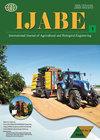Development of the precision feeding system for sows via a rule-based expert system
IF 2.2
2区 农林科学
Q2 AGRICULTURAL ENGINEERING
International Journal of Agricultural and Biological Engineering
Pub Date : 2023-01-01
DOI:10.25165/j.ijabe.20231602.7427
引用次数: 1
Abstract
: To precisely meet the nutritional requirements of sows during the stages of pregnancy and lactation, a precision feeding system was developed by using the intelligent sow feeder combined with a rule-based expert system and the Internet of Things (IoTs). The model of uncertain knowledge representation was established for inference by using the certainty factor. The daily feeding amount of each sow was calculated by the expert system. An improved pattern matching algorithm Reused Degree Model-RETE (RDM-RETE) was proposed for the decision of daily feeding amount, which sped up inference by optimizing the RETE network topology. A prediction model of daily feeding amount was established by a rule-based expert system and the precision feeding was achieved by an accurate control technology of variable volume. The experimental results demonstrated that the HASH-RDM-RETE algorithm could effectively reduce the network complexity and improve the inference efficiency. The feeding amount decided by the expert system was a logarithmic model, which was consistent with the feeding law of lactating sows. The inferential feeding amount was adopted as the predicted feed intake and the coefficient of correlation between predicted feed intake and actual feed intake was greater than or equal to 0.99. Each sow was fed at different feeding intervals and different feed amounts for each meal in a day. The feed intake was 26.84% higher than that of artificial feeding during lactation days ( p <0.05). The piglets weaned per sow per year (PSY) can be increased by 1.51 compared with that of relatively high levels in domestic pig farms. This system is stable in feeding and lowers the breeding cost that can be applied in precision feeding in swine production.基于规则的专家系统开发母猪精密饲养系统
:为精确满足母猪孕期和哺乳期的营养需求,将智能母猪喂料机与基于规则的专家系统和物联网相结合,开发了一套精确喂料系统。利用确定性因素建立不确定知识表示模型,进行推理。利用专家系统计算每头母猪的日采食量。提出了一种改进的可重用度模型-RETE (RDM-RETE)模式匹配算法,通过优化RETE网络拓扑结构,提高了推理速度。采用基于规则的专家系统建立了日进料量预测模型,采用变体积精确控制技术实现了精确进料。实验结果表明,HASH-RDM-RETE算法可以有效降低网络复杂度,提高推理效率。专家系统确定的投喂量为对数模型,符合泌乳母猪的饲喂规律。预测采食量采用推理采食量,预测采食量与实际采食量的相关系数大于等于0.99。每头母猪按不同的饲喂间隔和一日每顿不同的投料量饲喂。泌乳日采食量比人工饲养高26.84% (p <0.05)。与国内较高水平的猪场相比,每头母猪年断奶仔猪数(PSY)可提高1.51头。该系统饲喂稳定,降低了养殖成本,可应用于养猪生产中的精准饲养。
本文章由计算机程序翻译,如有差异,请以英文原文为准。
求助全文
约1分钟内获得全文
求助全文
来源期刊

International Journal of Agricultural and Biological Engineering
AGRICULTURAL ENGINEERING-
CiteScore
4.30
自引率
12.50%
发文量
88
审稿时长
24 weeks
期刊介绍:
International Journal of Agricultural and Biological Engineering (IJABE, https://www.ijabe.org) is a peer reviewed open access international journal. IJABE, started in 2008, is a joint publication co-sponsored by US-based Association of Agricultural, Biological and Food Engineers (AOCABFE) and China-based Chinese Society of Agricultural Engineering (CSAE). The ISSN 1934-6344 and eISSN 1934-6352 numbers for both print and online IJABE have been registered in US. Now, Int. J. Agric. & Biol. Eng (IJABE) is published in both online and print version by Chinese Academy of Agricultural Engineering.
 求助内容:
求助内容: 应助结果提醒方式:
应助结果提醒方式:


